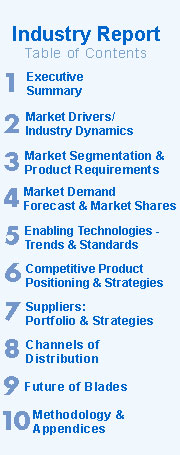
Heading No. 1: Title of newsletter
Click on Executive Summary, TOC, keynote presentation, Resources for additional information.
Heading No.2: Title of article
 |
 Text No.1 goes here.
Text No.1 goes here.
environment improving the productivity of IT assets has become a top priority for CIOs, given the average CPU running around 25% capacity while stranded direct-attached storage being utilized below 50% in many large companies. .
Text No.1 goes here
Driven by the lure of volume economics inherent in their scalable modular architecture, blades are ushering in a paradigm shift in the IT industry, enabling their adoption as blade PCs, modular small to medium servers all the way to high performance supercomputers. Consolidation achieved through integration of industry standard servers, storage and network elements and using virtualization and autonomic management lie at the heart of this paradigm shift.
Server, Storage, Networking and Management Blades
interconnected through high-speed fabric midplane are, in effect the Local Area
Grids (LAG©s) of today, showing up in Next generation Data Centers. They will,
in the future, become the nodes connected in Wide Area Grids (WAG©s) at the
Campus, Metro, and Long Haul environments.
The integrated modular architecture
of blade systems providing Virtualization, Provisioning and Self-Driven
Automation capabilities already are starting to strike a pleasant chord with
CIOs. These blades-based solutions are increasing efficiencies and reduce total cost of
ownership by as much as 45% in both IT computing and IP Telecommunications infrastructures. As open standards further crystallize at the physical and API
interface levels, vendors are creating product differentiation at the
middleware, data management, and vertical industry solutions levels.
The real cost reduction is happening as the Tier-1 (Edge Computing), Tier-2 (Application Servers) and Tier-3 (Data Base Servers running Transaction Processing & eCommece applications) separate servers give way to Blade Servers with an integrated structure and using Virtualization & Autonomic Management for cost effective data center consolidation.

1474 Camino Robles |
Heading No.2: Title of article
Some of the major growth drivers accelerating the adoption of blade servers include:
- UNIX to Linux Migrations to leverage cost effectiveness
of open source Linux
- HPC Linux Clusters have fueled an explosive growth in
academia and national laboratories for scientific computing and are
migrating to the commercial world for bio-informatics, Wall Street
decision support financials, medical visualization, and other
applications.
- Server Consolidation onto fewer servers with
virtualization of resources, provisioning and lights out automation
capabilities
- Blades Density to provide
economic benefits in real estate and operational metrics.

"Blade
Servers will continue to experience an explosive growth in the future, growing
to 34% of all server shipments by 2009. The total market opportunity is
projected to be over $27 billion in blade systems (five year cumulative revenues during 2005-09) and over $31 billion in Blade Systems and Services,
opening up major opportunities for semiconductor, boards, interconnect fabrics,
systems, middleware and services vendors and for associated venture investments”
said Anil Vasudeva, Principal Analyst & Founder of IMEX Research, a
technology markets research and consulting company, based in San Jose,
California.
Click here for additional information including vender positioning index (Strategy/Vision vs. Delivery/ Execution)
Click on the following for additional information or go to http://www.imexresearch.com.
IMEX Research, 1474 Camino Robles San Jose, CA 95120 (408) 268-0800 http://www.imexresearch.com
If you wish not to receive any IT information/news from IMEX, please click here